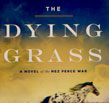 |
 |
12-11-09: Arturo Pérez-Reverte Revisits 'The Club Dumas' : The Subterranean Substance
Sometimes we readers just need a nudge to start reading an author we know by all rights should be worth our time. Enter Subterranean Press, with gorgeous re-issues of recent novels like 'The Shadow of the Wind'. The appeal is two-fold; you get a great-looking book, to be sure, but also you get a book with the editorial imprimatur of Subterranean Press. But it is not as if we are unfamiliar with Arturo Pérez-Reverte. It's just been four years since we last looked at 'The Flanders Panel.
In those years, Pérez-Reverte has continued to write intellectually challenging and thrillingly imaginative literary mysteries. So if you need a reason to dip in, why not order 'The Club Dumas' (Subterranean Press ; January 2010 ; $125), with a look and feel like that of 'The Shadow of the Wind'? We'll get to the look and feel aspect a bit more later. But as ever, what is most vitally important here are the words and the story.
Look, if you're going to go out and spend $125 on a book, it had better damn well stand up to re-reading, and 'The Club Dumas' by Pérez-Reverte is a grand example. 'The Club Dumas' features a character that readers can't help but love; the book hunter Lucas Corso, a man who gets his hands dirty finding "the exact dusty corner of an old man's shop where a book now worth a fortune lay forgotten." He's tasked with verifying the authenticity of some hand-written pages from 'The Three Musketeers' and the Necronomicon-like 'The Book of the Nine Doors to the Kingdom of Shadows.' Clearly the fate of anyone given this assignment is in doubt. But Pérez-Reverte does a lot more than send his book hunter in a labyrinth of terror.
The re-readable appeal of 'The Club Dumas' lies in the intricately constructed narrative, which takes readers though musings on the importance of books and the keystone effect they can have in our world as a whole and in our lives as individuals. Pérez-Reverte writes carefully crafted prose that evokes exotic places in reality and in literature.
All this exotic prose and story is matched by peerless Subterranean production values. Once again, Vincent Chong is doing full-color paintings and a full-color cover as well as a passel of duo-tone images embedded in the book. Like 'The Shadow of the Wind,' the type will be set in two colors, and the hardcover will use the same sort of heavy paper and binding. You're getting a quality book to enhance your reading experiences — and I use the plural here deliberately, because you will want to re-read this novel.
There's a great sense of the fantastic at work in 'The Club Dumas,' grounded in the dark corners of our imaginations and powered by the reading experience itself. Because ultimately, there is in our lives one quite easy manner in which we may experience the fantastic in reality — by opening up the pages of a book.
|
|
12-10-09: Andrew Porter Explains 'The Theory of Light and Matter' : Pilfered and Prize-Winning
Andrew Porter has a message for his fellow writers.
Back up your work — and make sure that there is an offsite copy.
Porter learned the hard way. He'd had his stories published in all the right journals, had an agent, had won contests — he had arrived. Until his apartment was robbed and all of his work, everything hard copies as well as his computers, hard drives and floppies (remember those?) — gone. In the computer world you call that a hard reset.
That was ten years ago. Last year, in 2008, Porter submitted a collection of short stories to the Flannery O'Connor Contest, and won. University of Georgia Press published 2,000 copies of 'The Theory of Light and Matter' (Vintage / Random House ; January 5, 2010 ; $14), soon to be available as a trade paperback from the Vintage Books imprint over at Random House. Perhaps obviously, the old Grateful Dead lyric applies — "what a long, strange trip it's been."
Porter journeyed to the edge of giving up, but managed to avoid that cliff, and readers who enjoy the classic American Short story, served up straight with a side order of edgy intensity, will reap the rewards. Porter's stories are sparse but powerful, and turn everyday events into omens of ill to come. In "The hole," two boys peer down into a sewage vent after one drops a bag of leaf clippings. It's the unknown and it's not friendly. But it is also a story and subject to dreams, to memory slips, to revision.
Porter's own story is nearly as compelling as what he writes; the theft, the aftermath, the years struggling to write stories and the utterly changed publishing environment. Back in the day, before the theft, short story collections were unusual, but not verboten. These days, you have to be pretty damn special to have a collection like this published, but then the Flannery O'Connor prize would be an indication that Porter is indeed special. The collection supports this theory of publishing that matters; the stories here unfold in a variety of locations and offer us a childless couple, a teenage boy, a woman looking for her soul mate — life's rich pageant, so to speak. More precisely, America's tormented present, horror stories without the supernatural elements, knife-twisters that grip the reader for those intense moments of short-story reading.
Short stories are a peculiar and under-appreciated reading experience. These aren't just novels-in-waiting. Porter understands that the form does something very unique and very different. He uses the form push the reader firmly into places where it is difficult to go, into lives that are tough to live. Perhaps the fact that he hasn’t had it so easy himself makes it easier for him to write about the horrors that greet us every day. Greet them here in prose first. Explore those emotional places you will with luck never have to experience in person. Back up your work.
That was ten years ago. Last year, in 2008, Porter submitted a collection of short stories to the Flannery O'Connor Contest, and won. University of Georgia Press published 2,000 copies of 'The Theory of Light and Matter' (Vintage / Random House ; January 5, 2010 ; $14), soon to be available as a trade paperback from the Vintage Books imprint over at Random House. Perhaps obviously, the old Grateful Dead lyric applies — "what a long, strange trip it's been."
Porter journeyed to the edge of giving up, but managed to avoid that cliff, and readers who enjoy the classic American Short story, served up straight with a side order of edgy intensity, will reap the rewards. Porter's stories are sparse but powerful, and turn everyday events into omens of ill to come. In "The hole," two boys peer down into a sewage vent after one drops a bag of leaf clippings. It's the unknown and it's not friendly. But it is also a story and subject to dreams, to memory slips, to revision.
Porter's own story is nearly as compelling as what he writes; the theft, the aftermath, the years struggling to write stories and the utterly changed publishing environment. Back in the day, before the theft, short story collections were unusual, but not verboten. These days, you have to be pretty damn special to have a collection like this published, but then the Flannery O'Connor prize would be an indication that Porter is indeed special. The collection supports this theory of publishing that matters; the stories here unfold in a variety of locations and offer us a childless couple, a teenage boy, a woman looking for her soul mate — life's rich pageant, so to speak. More precisely, America's tormented present, horror stories without the supernatural elements, knife-twisters that grip the reader for those intense moments of short-story reading.
Short stories are a peculiar and under-appreciated reading experience. These aren't just novels-in-waiting. Porter understands that the form does something very unique and very different. He uses the form push the reader firmly into places where it is difficult to go, into lives that are tough to live. Perhaps the fact that he hasn’t had it so easy himself makes it easier for him to write about the horrors that greet us every day. Greet them here in prose first. Explore those emotional places you will with luck never have to experience in person. Back up your work.
|
|
12-09-09: Return to Nowhere in 'Interfictions 2' : Falling Between the Cracks Into Eternity
"With enough data, maybe I can figure out the world," writes Shira Lipkin in "Valentines," one of many category-defying stories in 'Interfictions 2' (Small Beer Press ; November 3, 2009 ; $16). It's the perfect summation, in many ways, of the self-confounding literary intent that hovers in the interstices of this collection that itself hovers in the interstices. The statement and the collection are obvious truths and untruths, delightfully absurd. Or, as the Firesign Theatre once put it, "How can you be in two places at once when you’re not anywhere at all?"
Back in the 1980's, I spent some time playing music in what we'd now call a New Wave band. But back then, we didn't want to be categorized. I called the band Pets Gone Wild, a self-fulfilling prophecy about how your kids grow up to be whatever you cannot expect. But there was a band on the circuit that I thought had the ultimate name; a name so perfect that it literally disappeared. That was "TBA." Very clever, that was, too clever by half, since any announcement of an appearance or listing for a club transformed them into the ultimate anonymity. They became pure expectation, and never made a name for themselves. You could not know what to expect.
That's the idea behind the Interfictions anthologies published by Small Beer Press. If they loved man-in-suit monster movies, they could really call them "Destroy All Expectations!" But the point is, it doesn't matter what you call it; perhaps, in that regard, they should call if "Title TK." The idea is to produce a collection of writing that defies categorization and expectations, and here they've done an ace job. Because our expectations cross more than just genre, content or intent.
'Interfictions 2,' edited by Delia Sherman and Christopher Barzak obviously has a lot going for it out of the gate. But to address the core values of the work, let's start with Henry Jenkins who makes a wonderful argument for the premise behind the series, hurling critical firebombs left, right and center. Not satisfied with destroying boundaries, he wants to destroy the idea of boundaries. If he could, he'd go back in time and prevent the grandfather of boundaries from meeting the grandmother of boundaries. His essay, "On the Pleasures of Not Belonging" is the sort of writing that makes Playboy a vital literary establishment in spite of what Thomas Frank calls, "the comely lasses." Jenkins writing is energetic, enjoyable and quite intelligent. You can buy 'Interfictions 2' and justify it in a heartbeat saying, "I bought it for the criticism."
But you didn't and shouldn't buy it just for the criticism. There's a lot of great fiction here that defies expectations is perhaps the most critical manner. Look at the author list on the back of the book and you'll note that you probably have not read most of the writers here. This is not the usual suspects. Oh there are a few here, to be sure; Jeffrey Ford, Theodora Goss, M. Rickert, Ray Vukcevich, Brian Francis Slattery, and Lavie Tidhar will strike a nerve with a very select percentage of readers. But the idea is, I hope that 'Interfictions 2' with stories like Peter Ball's "Black Dog: A Biography," a wonderfully Fortean confabulation of life internal and external, get out beyond the purview of those who will recognize that list of names. Let me take the time to mention it's a nice book; well produced, nice pages; solid and easy to read. Small Beer hired well. Here's a book that is full of lively and unexpected reading, stories that will stick with you because they have fallen through the cracks into a literary eternity that frees them from expectations. Buy it for the words, first to last.
|
|
12-08-09: William Horwood Reveals 'Hyddenworld' : Fantasy and the War to Write It
We all have our prejudices when it comes to reading, and generally, they mean we miss out on works we might otherwise enjoy. For example, I've just never, never been able to generate any interest in talking animal fantasy. Oh, as a kid, I grew up on Winnie the Pooh. I still have my 1961 re-print of 'The House on Pooh Corner.' These books were the reason I started reading. But since then — nothing.
Admittedly, in the heyday of adult talking animal fantasy, I wasn't that interested in reading any fantasy. I might have dipped into a Michael Moorcock title now and again, or gone back to Conan or even Mervyn Peake, but other than that, I felt that fantasy had undergone a sort of Love Boat transformation in the 1970's and that everything thereafter was some sort of ultra-schmaltz. Nobody could convince me to read the rabbit books, no matter how much blood and sex there supposedly was, or to experience the savage war of moles that transpired in the Duncton Wood novels by William Horwood.
I moved on and so has Horwood, and now umpty-ump years later, he's back with a new fantasy series in the works that is utterly engaging. 'Hyddenworld: Spring' (Pan Macmillan UK ; February 2010 ; £16.99) is the first of four novels in a new fantasy series by William Horwood centered on the trials of a race of "little people" who have lived unseen on the borders of our world, but now must cross over to save both worlds from destruction.
|
|
Pan Macmillan Trade Edition |
Sure, it seems a familiar premise; a lost shard of enchantment, a young untested boy, a crabby aging man —but Horwood has the writerly magic to make this all come alive. NO matter how many times you;ve read about these sorts of things, no matter how many times these avenues have been explored, in the end it is the writer's craft that makes it work or not work and Horwood simply has the craft, in fact, the magic to make the familiar seem thrillingly new. For one, thing, we get from the fantasy world to our more familiar world at a perky pace. Everything happens pretty quickly here, but not at the rush of a hollow thriller. Instead, the thrills are in discovering Horwood's wonderful prose. There's a level of artistry from the get-go that makes 'Hyddenworld: Spring' engrossing and exciting, not just in a what's-going-to-happen sense, but in a I-want-to-read-the-prose, I-want-to-explore-this-world sense. Horwood has a real gift for the writing.
Of course, part of that gift proves to be more than just an innate talent for putting words together. (Which cannot be imitated or underestimated.) Horwood says in a one-page forward attached to the advance reading copy that, "I had to leave my desk, don my boots, and return to the world that made me." That translates to research, and apparently, a lot of walking around to make sure he got the details right. He makes it sound like a marching into battle; there's a rather military vibe to his approach to research. I've never been to the places he describes, so I can't say that he got it right based on experience. But I can say that whatever he did enabled him to re-create the world in a compelling and interesting manner. In the first and the final accounting, reading is about how the book reads. This book reads extremely well.
One last proviso, as this is a series. I've generally been the sort of fellow who won't start a series until I see the last book come out. But as I understand it, Horwood is about to turn in book two ... so one can have a better-than-average hope that we'll gedt the whole thing in a timely manner. And given the seasonal names, one can hope that there will only be four, so also good on that. On the other side of the coin, things start out pretty dire in a book titled 'Spring.' The final book is obviously titled 'Winter.' The books involve environmental disaster; and ending in Winter doesn't bode well. This Winter, we can all start 'Spring' and hope for the best — but so far as Horwood's world goes, I'm planning for the worst. One hopes that reality does not follow in the footsteps of Horwood's fantasy.
|
|
12-07-09: Breaking the Bread Baking Barrier : Five, Well Maybe Fifteen Minutes Per Day
I love to cook. But baking has always seemed beyond me. Sure, I can throw together a cake mix. But baking my own bread has thus far proved disastrous. I had a bread machine for a brief while, and duly turned out lumps of something that didn't resemble bread in any way; select group, drag to trash. I figured that if I couldn't make bread in a bread machine, I surely could not do so otherwise. And certainly not easily enough to make it worth my while. I was wrong.
When I got the books 'Healthy Bread in Five Minutes a Day: 100 New Recipes Featuring Whole Grains, Fruits, Vegetables, and Gluten-Free Ingredients' (Thomas Dunne Books / St. Martin's Press ; October 27, 2009 ; $27.99) and 'Artisan Bread in Five Minutes a Day: The Discovery That Revolutionizes Home Baking' (Thomas Dunne Books / St. Martin's Press ; November 13, 2007 ; $27.99) by Jeff Herzberg and Zoe Francois, I thought I mind end up doing a bit of debunking. I thought I'd get the books and find them impossibly complicated; and for me, I thought, they'd provide only recipes for failure. To say that I was skeptical would be underestimating matters. Note from above — I couldn't even get a bread machine to work.
Out of the box, I found I was wrong. The books each begin with a "master recipe" and the authors stress that the cook should not stress. Measure the flour quickly, with a "scoop and scrape" technique — I did that, easily enough. Three cups of lukewarm water, mix in yeast and salt. That was not hard either. Then, pour the liquid into the flour and mix with a wood spoon. Again, easy enough for even me. The total mixing time was maybe ten minutes, max. It certainly seemed too easy and destined to fail. You want a big bowl to store the dough in — 5 to 6 quarts. That was the hardest part — but doable. Then, let the dough rise for two hours — I waited three. Then refrigerate overnight. Even I could do that, though it involved shuffling around some beer bottles. The next day, take out a blob of dough. Flour it a little, shape it a bit into a nice oval. Let it rise for 40 minutes. I let mine go a little longer. (More about this later.) Preheat your oven to 450 with a pizza stone and a small, empty broiler pan. Slide the oval onto the stone and toss a cup of water into the broiler pan. Cook for some 20-30 minutes, remove and you've got hot bread.
And it actually, factually works. Now here's the proviso. To my mind, you're best off letting that blob (or however else you make it, more on that later), rise for at least two hours, maybe even more. It certainly hasn't hurt in my experience. Now, in part that may be because I keep my house pretty cold -55-60 F most days. So when you get the books, and you should, experiment. They'll all pretty much be successful.
Here's the real deal. Once you have that big blob of dough, you can make a lot of different things from it. I turned one basic recipe into cinnamon rolls, orange marmalade rolls, a loaf of bread and a pizza crust. If you make rolls, just take out a handful, flatten it or roll it (flour the surface on which you do this), spread with butter, then spread with brown sugar and cinnamon or orange marmalade and a bit of orange zest [not very much, just a hint]. Roll the sheet up, slice into rolls, place into a spray-oiled baking pan, let them rise one to five hours (I've done both extremes and points in-between), then cook at 350 F for 30 minutes. When you have this blob, you can have fresh, home-made cinnamon rolls with about fifteen minutes of prep and a couple of hours of rising, and half-an-hour of baking.
Now, the two provisos then are — rising time tends to need to be longer. I go with at least two hours in my chilly house. And, once you start doing this, and finding out how easy it is to have fresh bread or rolls or pizza crust whenever you want, it's deadly. You can keep the dough refrigerated for up to two weeks. The books have a variety of recipes that are all tasty — and the second one focuses on healthy wheat bread and gluten-free breads. You'll have to double your morning exercises just to keep from bloating because the bread is better than anything you can buy and much, much, cheaper.
You cannot find a better book to buy for a Christmas gift. Buy both for yourself, test-drive the recipe and then when you give both to your lucky recipient(s) you can offer pertinent tips. There are a lot of different recipes in these books, both for the basic and not-so-basic breads and for meals that involve the bread itself as an ingredient. If you buy bread, you'd do well to buy these books. Soon you won’t be buying bread, you'll be making it. It's so much better made at home, you'll never go back.
|
|
|
 |
|
|
|




